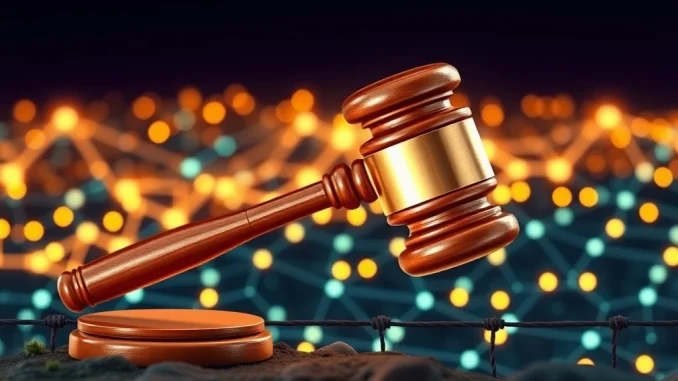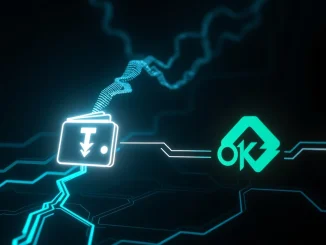
Are we on the cusp of a regulatory revolution in the crypto world? Recent statements from U.S. Treasury Secretary Scott Bessent suggest a significant shift in how the government views blockchain and stablecoins. For crypto enthusiasts and innovators, this news could be a game-changer. Let’s dive into what this reevaluation of blockchain regulation might mean for the future of digital assets and the broader financial landscape.
U.S. Treasury Reassesses Blockchain Regulation for Innovation
Speaking at the American Bankers Association conference, Treasury Secretary Bessent indicated that the current administration is taking a hard look at existing regulations that might be stifling progress in the exciting fields of blockchain technology, stablecoins, and new payment systems. This isn’t just about tweaking existing rules; it’s a fundamental reassessment to ensure regulations are fostering, not hindering, innovation.
Here’s what we know:
- Pro-Innovation Stance: The Treasury is actively seeking to identify and remove regulatory obstacles that impede the growth of blockchain and stablecoins.
- Economic Growth Focus: These reforms are being pursued with the broader goal of strengthening U.S. capital markets and promoting overall economic expansion.
- Balanced Approach: The aim is to create a regulatory environment that is fair and beneficial for both large financial institutions (Wall Street) and everyday consumers (Main Street).
- Financial Inclusion Priority: Expanding access to financial services is a key driver behind this regulatory reform initiative.
This announcement signals a potentially powerful shift in the U.S. government’s approach to crypto assets. Instead of a purely cautious or restrictive stance, we’re seeing an emphasis on fostering innovation while ensuring a balanced and inclusive financial system.
Why is Stablecoin Regulation Under Review?
Stablecoins have emerged as a crucial bridge between traditional finance and the crypto world. Their value, pegged to fiat currencies like the US dollar, offers stability in the often volatile cryptocurrency market. However, their rapid growth has also attracted regulatory scrutiny.
The current review of regulations concerning stablecoins likely stems from a few key factors:
| Factor | Explanation |
|---|---|
| Rapid Market Growth | The explosive growth of stablecoins has caught the attention of regulators who are keen to understand and manage potential systemic risks. |
| Financial Stability Concerns | Regulators are evaluating whether stablecoins could pose risks to financial stability, particularly in terms of reserve management and redemption processes. |
| Payment System Innovation | Stablecoins are seen as having the potential to revolutionize payment systems, offering faster and cheaper transactions. Regulations need to keep pace with this innovation. |
| Clarity Needed | The regulatory landscape for stablecoins is still evolving, and clearer guidelines are needed to provide certainty for businesses and investors. |
By reevaluating stablecoin regulation, the Treasury aims to strike a balance: allowing stablecoins to flourish as a tool for innovation while mitigating potential risks and ensuring consumer protection.
Crypto Innovation: What Does Regulatory Reform Mean for the Industry?
The prospect of regulatory reform is generating considerable excitement within the crypto industry. For years, many in the space have argued that overly restrictive or unclear regulations have stifled crypto innovation in the U.S., pushing talent and investment overseas. A more balanced regulatory environment could potentially reverse this trend and unlock significant opportunities.
Potential benefits of regulatory reform for crypto innovation include:
- Increased Investment: Clearer rules and a more supportive regulatory stance could attract greater institutional and retail investment into the crypto space.
- Business Growth: Startups and established companies in the blockchain and crypto sectors would have a more predictable and favorable environment to operate and expand.
- Technological Advancement: Reduced regulatory uncertainty could encourage greater experimentation and development of new blockchain-based technologies and applications.
- Job Creation: A thriving crypto industry in the U.S. would lead to the creation of new, high-skilled jobs in technology, finance, and related fields.
However, it’s crucial to acknowledge that regulatory reform is a complex process. The goal is not deregulation, but rather smarter regulation that fosters innovation without sacrificing important safeguards.
Financial Inclusion: A Key Driver for Regulatory Change
Secretary Bessent specifically highlighted financial inclusion as a priority in the administration’s regulatory reform vision. This is a significant point, as it suggests that the government recognizes the potential of blockchain and crypto technologies to expand access to financial services for underserved populations.
How can blockchain and stablecoins promote financial inclusion?
- Lower Transaction Costs: Blockchain-based payment systems can significantly reduce transaction fees, making financial services more affordable for low-income individuals.
- Increased Accessibility: Cryptocurrencies and digital wallets can provide access to financial services for people who lack traditional banking relationships.
- Faster Remittances: Blockchain technology can streamline and speed up international remittances, reducing costs for migrant workers sending money home.
- Transparency and Security: Blockchain’s inherent transparency and security features can build trust and confidence in financial systems, particularly in regions with less developed infrastructure.
By prioritizing financial inclusion, the Treasury is signaling that it sees blockchain and stablecoins not just as speculative assets, but as tools that can contribute to a more equitable and accessible financial system for all Americans.
Navigating the Path Forward: What to Expect from Regulatory Reform
While the Treasury Secretary’s statements are encouraging, it’s important to remember that regulatory reform is a process that takes time and involves multiple stakeholders. We can expect to see further developments in the coming months and years as the administration moves forward with its reevaluation.
Key aspects to watch for:
- Specific Regulatory Changes: The details of the regulatory reforms will be crucial. Will they focus on streamlining licensing processes, providing clearer guidance on stablecoin reserves, or addressing other specific pain points for the industry?
- Inter-Agency Coordination: Effective regulatory reform will require coordination between various government agencies, including the Treasury, the SEC, and other relevant bodies.
- Industry Engagement: The success of regulatory reform will depend on meaningful engagement with the crypto industry to understand its needs and challenges.
- Global Alignment: As crypto is a global phenomenon, international cooperation and alignment on regulatory standards will be important.
This is a developing story, and the crypto community will be closely watching for further signals and concrete actions from the U.S. Treasury. The potential for regulatory reform to unlock a new era of crypto innovation and financial inclusion is immense, and the coming period promises to be both exciting and pivotal.
Conclusion: A Bold Vision for Blockchain and Stablecoins
Secretary Bessent’s remarks represent a potentially transformative moment for the U.S. crypto industry. The administration’s commitment to reevaluating blockchain regulation and fostering stablecoin growth, with a focus on financial inclusion and crypto innovation, is a welcome development. By aiming for a balanced regulatory approach, the U.S. could position itself as a global leader in the burgeoning digital asset space, driving economic growth and expanding financial access for all. The journey of regulatory reform is just beginning, but the direction is undeniably positive, offering a hopeful outlook for the future of crypto in America.



